Physical Address
304 North Cardinal St.
Dorchester Center, MA 02124
Physical Address
304 North Cardinal St.
Dorchester Center, MA 02124
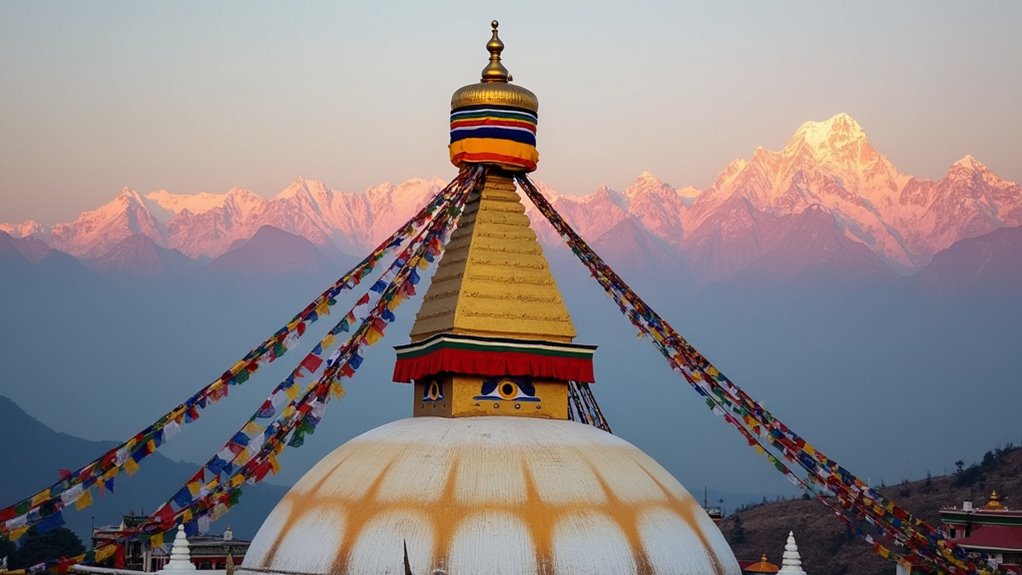
Magnificent Nepal landmarks await your discovery, from ancient durbar squares to Everest's majesty—but which ones truly deserve your limited time?
Nepal’s must-visit landmarks include the UNESCO-listed Kathmandu, Patan, and Bhaktapur Durbar Squares, showcasing centuries of Newari craftsmanship. Don’t miss Pashupatinath Temple, Boudhanath Stupa, and Swayambhunath for spiritual experiences. Adventure seekers can trek to Everest Base Camp, spot wildlife in Chitwan National Park, or try paragliding in Pokhara. Visit during October-November or March-May for ideal weather. These attractions offer just a glimpse into Nepal’s abundant cultural and natural heritage.
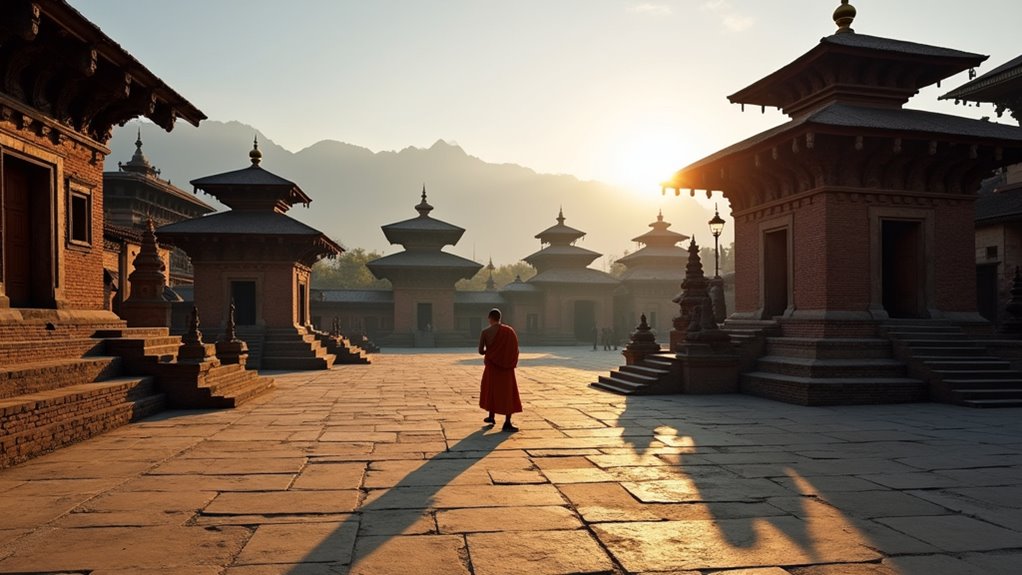
When you first step into Kathmandu Durbar Square, you’re walking through 17 centuries of Nepalese history. This UNESCO site served as the royal center for both Malla and Shah dynasties, hosting coronations and political gatherings since the 3rd century.
Don’t miss the Hanuman Dhoka palace complex with its nine-story Nautalle Durbar, built during Nepal’s unification. The original construction of the square dates back to the 4th to 8th century, when it was established as a Royal Palace. The entrance fee (around $10) grants access to courtyards, museums, and the Kumari Chouk where the living goddess resides.
Visit early morning to avoid crowds and capture stunning photos of intricate wood carvings and stone sculptures. Following the 2015 earthquake damage, ongoing restoration work means some areas may be restricted, but the blend of Hindu and Buddhist architecture remains breathtaking even on a budget.
Just a few miles southeast of Kathmandu, Patan Durbar Square stands as the crown jewel of Newari craftsmanship, dating back to the 3rd century AD. This UNESCO World Heritage Site flourished under the Malla kings, blending Hindu and Buddhist traditions in its intricate architecture. The square’s impressive structures feature the distinctive Shikhara architectural style with tall, curved roofs and meticulous carvings that showcase exceptional craftsmanship.
Patan Durbar Square: where ancient Newari artistry meets Hindu-Buddhist harmony in the shadow of Kathmandu.
When visiting this historic gem, consider these essentials:
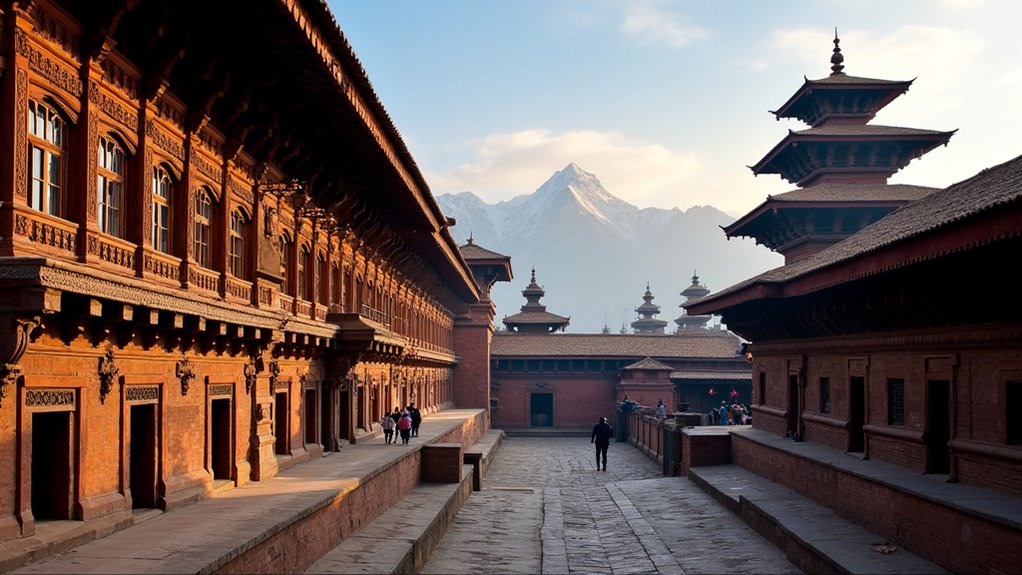
Located in the medieval city of Bhaktapur, the 55-Window Palace and Nyatapol Temple stand as magnificent examples of Nepalese craftsmanship from the early 18th century. Built between 1702-1722 during King Bhupatindra Malla‘s reign, the palace (locally known as Pachpannajhyale Durbar) features 55 intricately carved wooden windows offering panoramic views of the square.
Don’t miss the rare tempera paintings on the first floor—they’re among Nepal’s most unique. The palace’s upper level showcases a continuous balcony with latticed wooden screens and trilobate arches that demonstrate exceptional craftsmanship. Both structures are part of a UNESCO World Heritage Site, making them essential stops on your cultural tour.
The five-story Nyatapol Temple nearby demonstrates impressive Newari engineering skills.
Visit both landmarks on the same day to save time and money. Photography is free, but entrance fees apply for the Bhaktapur heritage area. Morning visits provide the best lighting for photos.
Pashupatinath Temple stands as Nepal’s most significant Hindu shrine, offering visitors a profound glimpse into ancient religious traditions just 5 kilometers from Kathmandu’s city center.
Dating back to 400 CE, this UNESCO World Heritage site features distinctive Nepalese pagoda architecture with intricate wooden carvings. The temple’s gold-covered copper roofs rest upon a square base that stands 23m 7cm high.
A temple where ancient history speaks through wooden artistry beneath Nepal’s iconic pagoda rooflines.
For the budget-conscious traveler, make the most of your visit with these essentials:
Non-Hindus can’t enter the main temple but can view it from across the river.
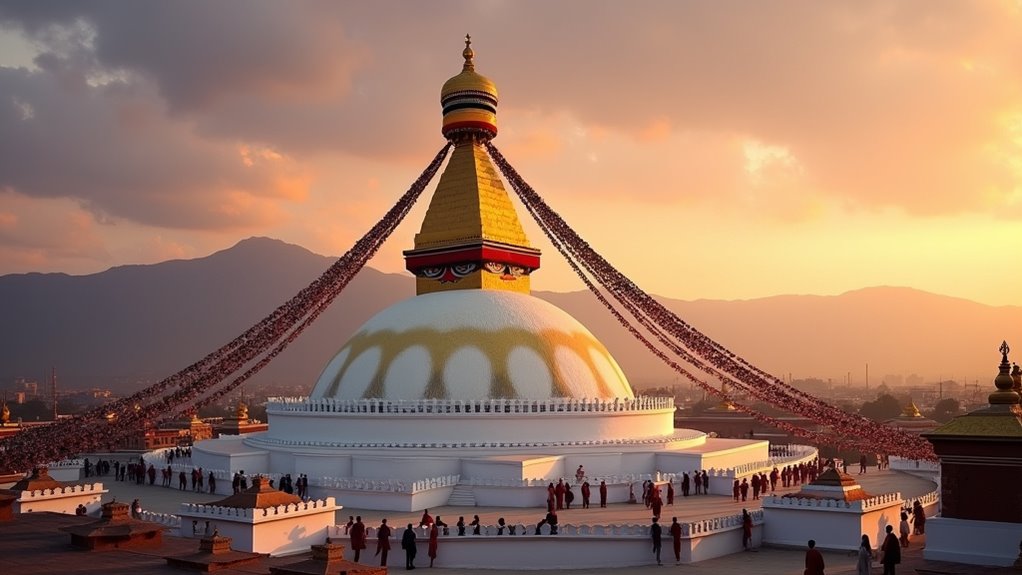
Rising majestically above Kathmandu’s skyline, Boudhanath Stupa stands as one of the largest spherical stupas in Nepal and a thriving center of Tibetan Buddhism. Built in the 1300s, this UNESCO site houses relics of Kassapa Buddha and serves as a spiritual beacon with over 50 surrounding monasteries. The stupa features a massive mandala and contains sacred consecrated substances and relics including remains of both Kassapa and Shakyamuni Buddha.
You’ll find the stupa buzzing with pilgrims performing clockwise circumambulations. Visit early morning to avoid crowds and witness monks in morning rituals. Entry costs 400 NPR ($3), but the fee is worth experiencing this resilient landmark that was beautifully restored after the 2015 earthquake with $2 million in donations.
Don’t miss the nearby Tibetan restaurants offering affordable momos (dumplings) while you soak in the spiritual atmosphere of this ancient trade route stopover.
Perched atop a hill overlooking Kathmandu Valley, Swayambhunath enthralls visitors with its gleaming white dome and watchful Buddha eyes. Dating back to 460 A.D., this ancient site beautifully blends Hindu and Buddhist traditions in one sacred space. The thirteen tiers above the dome symbolize the stages to enlightenment and represent the universe’s structure.
The fluttering prayer flags and resident monkeys create a unique atmosphere you won’t find elsewhere in Nepal.
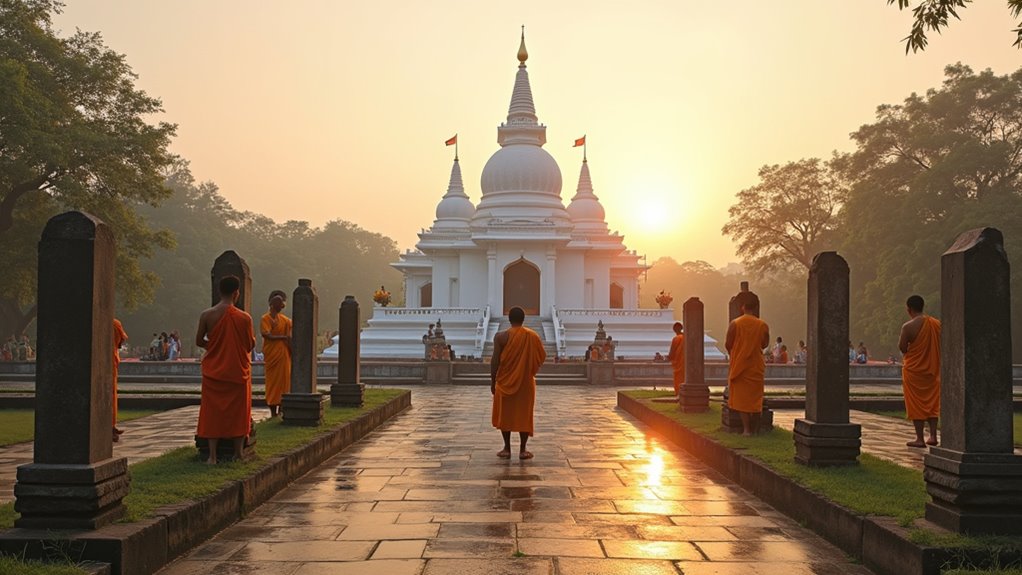
Nestled in the tranquil Terai plains of southern Nepal, Lumbini stands as one of Buddhism’s most sacred sites where Siddhartha Gautama (Lord Buddha) was born around 623 BCE.
This UNESCO World Heritage Site centers around the Maya Devi Temple, marking the exact birthplace with ancient brick structures dating to the 3rd century BCE.
Don’t miss the historic Ashoka Pillar, erected in 249 BCE, which definitively established this location as Buddha’s birthplace.
The sacred Puskarini Pond, where Buddha received his first bath, lies nearby.
You’ll find numerous monasteries built by Buddhist communities from different countries, offering free entry to most areas. The entire site follows architect Kenzo Tange’s 1978 master plan, which divides Lumbini into three zones based on Buddhist symbolism.
Visit during winter (October-March) for comfortable temperatures.
Allow a full day to explore, and consider hiring a local guide (₹500-1000) for deeper historical context.
The iconic trek to Everest Base Camp represents Nepal’s most famous adventure, drawing thousands of hikers annually to witness the world’s highest peak up close. This 12-14 day journey covers approximately 130 km from Lukla, reaching altitudes of 5,364m at Kala Patthar.
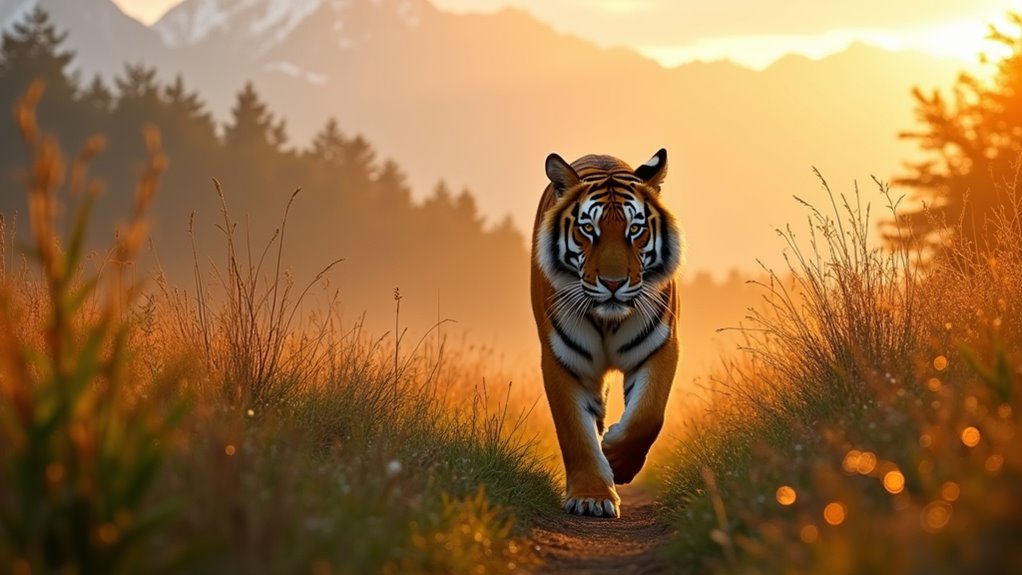
While Mount Everest draws adventure seekers to Nepal’s heights, Chitwan National Park offers equally spectacular wildlife encounters in the country’s southern lowlands. As Nepal’s first national park and a UNESCO World Heritage site, it boasts the highest biodiversity of any protected area in the country.
Beyond Everest’s snowy peaks lies Chitwan, Nepal’s biodiversity crown jewel in the southern plains.
You’ll have chances to spot some of the 82 Bengal tigers or the park’s thriving one-horned rhinoceros population. The park supports 68 mammal species, including rare sloth bears and leopards. Located within key biodiversity areas, Chitwan National Park plays a crucial role in regional ecological preservation efforts.
For bird enthusiasts, over 500 species await, from colorful kingfishers to majestic hornbills.
Book a guided safari jeep tour (more affordable in groups) or try a canoe ride along the rivers. The best wildlife viewing occurs during dry season (October-March) when animals gather around water sources.
Regarded as Nepal’s adventure capital, Pokhara serves as the perfect gateway to the majestic Annapurna mountain range. This lakeside city offers both relaxation and thrilling activities for travelers on any budget.
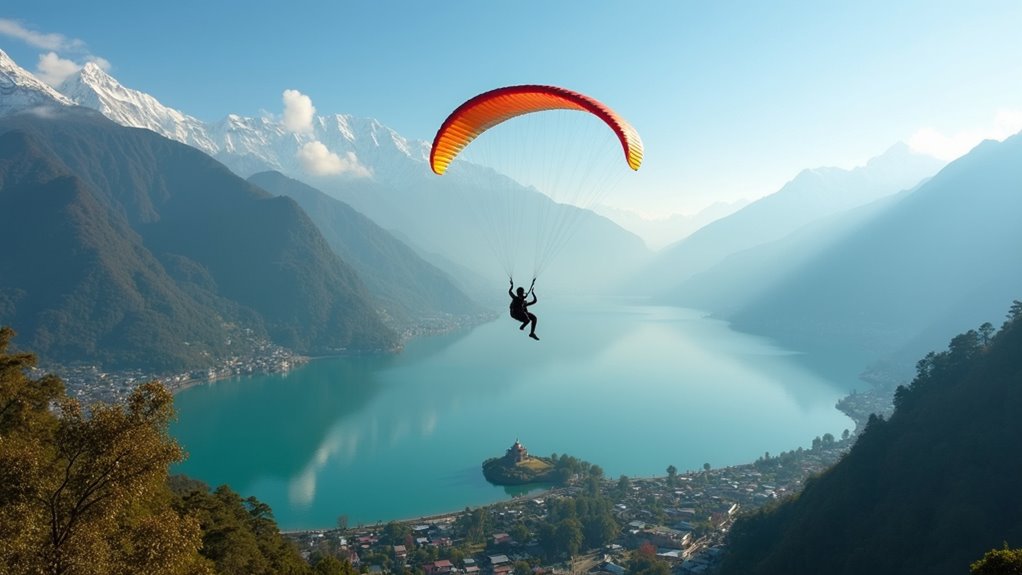
Soaring high above Phewa Lake, paragliding in Pokhara offers one of Nepal’s most exhilarating adventures without requiring any previous experience. Take off from Sarangkot, 2000 feet above the lakeside, with certified pilots who’ll handle all technical aspects after a thorough safety briefing.
The best times to fly are autumn (September-November) and spring (March-May) when clear skies maximize visibility of the Annapurna range and three 8000m+ peaks. For the truly unique experience, try parahawking with trained Egyptian vultures that interact with paragliders during flight. Flights typically last 20-60 minutes, with options ranging from gentle sightseeing to thrilling acrobatics.
Most operators include transportation from Pokhara via a 20-minute jeep ride. For the best value, consider combo packages that pair paragliding with other Pokhara activities. Sunrise and sunset flights offer spectacular lighting conditions over the lake.
Nepal’s natural and cultural gems give you grand value without draining your dollars. Pack proper protection and plan your path to maximize memorable moments. Whether you’re wandering ancient wonders or trekking towering trails, you’ll find fantastic, affordable adventures at every turn. Don’t delay – discover these dramatic destinations with a decent daily budget and you’ll create connections that continue to captivate long after you’ve left.